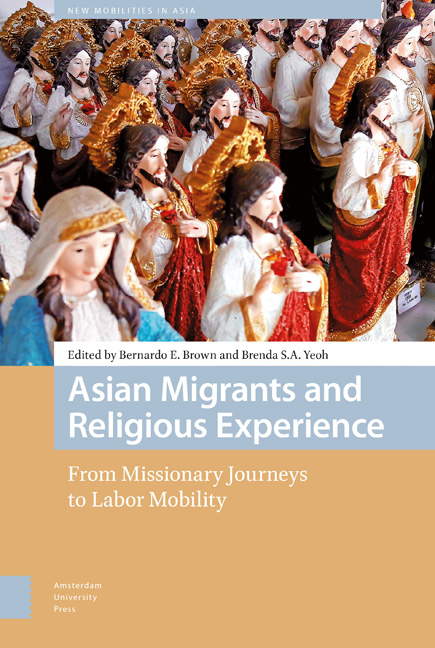Book contents
- Frontmatter
- Contents
- List of Illustrations
- Acknowledgments
- 1 Introduction: Human Mobility as Engine of Religious Change
- Section 1 Mobile Religious Practices
- 2 Saving Yogis: Spiritual Nationalism and the Proselytizing Missions of Global Yoga
- 3 Renewed Flows of Ritual Knowledge and Ritual Affect within Transnational Networks: A Case Study of Three Ritual Events of the Xinghua (Henghua) Communities in Singapore
- 4 Liberalizing the Boundaries: Reconfiguration of Religious Beliefs and Practice amongst Sri Lankan Immigrants in Australia
- Section 2 Transnational Proselytizing
- 5 From Structural Separation to Religious Incorporation: A Case Study of a Transnational Buddhist Group in Shanghai, China
- 6 “10/40 Window”: Naga Missionaries as Spiritual Migrants and the Asian Experience
- 7 Religion, Masculinity, and Transnational Mobility: Migrant Catholic Men and the Politics of Evangelization
- 8 Helping the Wounded as Religious Experience: The Free Burma Rangers in Karen State, Myanmar
- Section 3 Refashioning Religiosity in the Diaspora
- 9 A Multicultural Church: Notes on Sri Lankan Transnational Workers and the Migrant Chaplaincy in Italy
- 10 “Bahala Na Ang Diyos”: The Paradox of Empowerment among Filipino Catholic Migrants in South Korea
- 11 Feeling Hindu: The Devotional Sivaist Esthetic Matrix and the Creation of a Diasporic Hinduism in North Sumatra
- 12 Afterword: What Makes Asian Migrants’ Religious Experience Asian?
- References
- Index
12 - Afterword: What Makes Asian Migrants’ Religious Experience Asian?
Published online by Cambridge University Press: 12 December 2020
- Frontmatter
- Contents
- List of Illustrations
- Acknowledgments
- 1 Introduction: Human Mobility as Engine of Religious Change
- Section 1 Mobile Religious Practices
- 2 Saving Yogis: Spiritual Nationalism and the Proselytizing Missions of Global Yoga
- 3 Renewed Flows of Ritual Knowledge and Ritual Affect within Transnational Networks: A Case Study of Three Ritual Events of the Xinghua (Henghua) Communities in Singapore
- 4 Liberalizing the Boundaries: Reconfiguration of Religious Beliefs and Practice amongst Sri Lankan Immigrants in Australia
- Section 2 Transnational Proselytizing
- 5 From Structural Separation to Religious Incorporation: A Case Study of a Transnational Buddhist Group in Shanghai, China
- 6 “10/40 Window”: Naga Missionaries as Spiritual Migrants and the Asian Experience
- 7 Religion, Masculinity, and Transnational Mobility: Migrant Catholic Men and the Politics of Evangelization
- 8 Helping the Wounded as Religious Experience: The Free Burma Rangers in Karen State, Myanmar
- Section 3 Refashioning Religiosity in the Diaspora
- 9 A Multicultural Church: Notes on Sri Lankan Transnational Workers and the Migrant Chaplaincy in Italy
- 10 “Bahala Na Ang Diyos”: The Paradox of Empowerment among Filipino Catholic Migrants in South Korea
- 11 Feeling Hindu: The Devotional Sivaist Esthetic Matrix and the Creation of a Diasporic Hinduism in North Sumatra
- 12 Afterword: What Makes Asian Migrants’ Religious Experience Asian?
- References
- Index
Summary
Many of the most important studies on religion and migration published at the turn of the 21st century focused almost exclusively on European and American experiences – José Casanova's Public Religions in the Modern World (1994), Thomas Tweed's Crossing and Dwelling (2006), and Manuel Vasquez's More Than Belief: A Materialist Theory of Religion (2011). Although some of these studies do include mention of Asian immigrants in Europe or the Americas, they do not look at the specific features of migration within Asia, from one Asian country to another, or the ways in which Asian notions of religion are different from those most widespread in Euro-America. This volume thus provides a series of case studies which focuses on these subjects, and also (as a whole) emphasizes the potential for creativity, agency, and reinvention on the past of migrants who are often seen primarily as victims – displaced, discouraged, and disabled once they are separated from their home terrain.
As the editors have noted, this volume tries to move beyond a stereotype of the migrant, desperately clinging to a culture and religion which no longer make sense in the new context. Instead, they hope to focus on how a new setting can provide an opportunity for doctrinal innovation, religious revitalization, and ritual elaboration.
Asia presents quite a different religious field from Europe or the Americas, because Asian religions have traditionally been much more fluid and less exclusionary than the monotheistic creeds of the Abrahamic lineage (Judaism, Christianity, and Islam). Before European colonial conquest and the related missionary invasion, Asians often followed a teacher or a creed without feeling that it was necessary to renounce other teachers or creeds. It was only during the nineteenth century that European scholars made the teachings ofBuddha, Confucius, and Lao Tzu into “isms” (Masuzawa 2005). For well over a thousand years, the teachings of these three figures blended more or less seamlessly in China, Japan, Korea, and Vietnam, although there were periods where one tradition was clearly ascendant over the others (Duara 2015, 8-9).
The language of religious pluralism in both Europe and Asia emerged at the same time when a secular orientation became dominant in national politics and policies. Movements to modernize and rationalize Buddhism and Hinduism were influenced by secular critiques and values, as well as by ways in which the notion of “religion” came to be defined by European scholars.
- Type
- Chapter
- Information
- Asian Migrants and Religious ExperienceFrom Missionary Journeys to Labor Mobility, pp. 303 - 314Publisher: Amsterdam University PressPrint publication year: 2018



